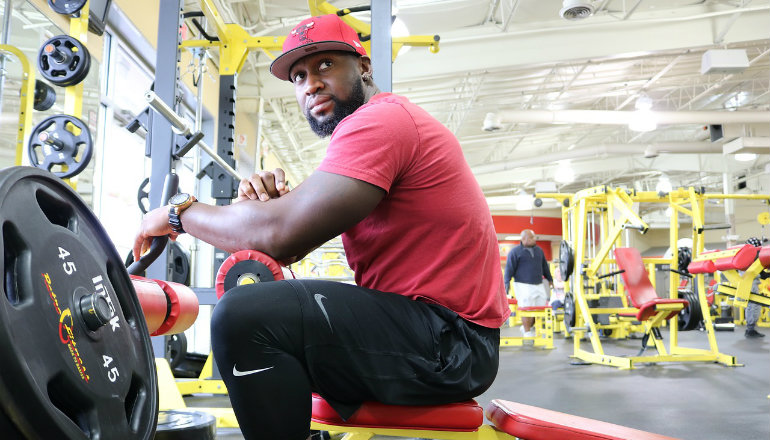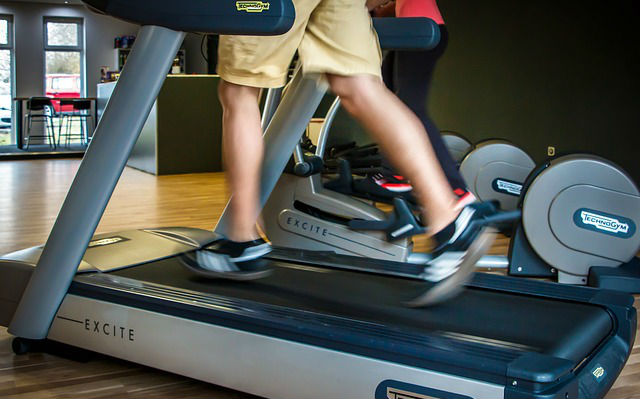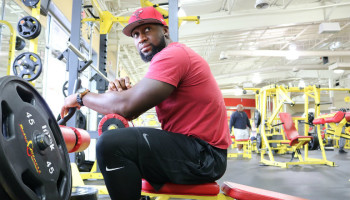 Reading Time: 7 minutes
Reading Time: 7 minutesIf you want to see something scary, take a look at the drivers around you next time you’re stopped at a traffic light or stuck in bumper-to-bumper traffic. It’s a good bet plenty of those drivers will have their heads down for one simple reason — they are looking at their phones.
Indeed, distracted driving is a serious problem. Some have even called texting and driving the new drinking and driving. With cars possessing the potential of being a deadly weapon, the stakes with distracted driving are high.
But it isn’t just behind the wheel where distraction is an issue. Distraction has become problematic in almost every facet of life, from the workplace to school to the movie theater. And, of course, distraction is also prominent at another place many of us visit — the gym.
Exercise has its own high stakes as any time we move our bodies, there exists the potential of doing harm to ourselves (and others). Even a simple exercise like walking presents the possibility for injury if we aren’t aware of our bodies in space and time. In fact, studies show more people are injured while walking and talking on their phone then while driving.
Still, you could contend that exercising while distracted is now the new norm or even the desired application of fitness. These days some fitness venues feel more like dance clubs or amusement parks than temples of health and wellness. It seems like the more bells and whistles, the more popular the concept. It can be difficult to even find a gym without gobs of technology interfaces, loud music, and flat screen TVs.
But some may see this application of technology as beneficial — you can evaluate health-related biofeedback in real time or watch your favorite TV program while on the treadmill. For some, distraction may feel like the key to creating an exercise habit and they create that distraction intentionally. But mindlessly falling into the distraction trap is both prevalent and problematic.
Here’s why you should (and shouldn’t) fall into the distraction trap and how you can keep focused on the task at hand while at the gym.
2 Reasons to Consider Distracted Exercise
You’re a means-to-an-end exerciser and/or you hate exercise.
I’ve always worked out after work. I have better energy in the early evening than the morning, but mostly I exercise after work because I look forward to it. It’s never something I’m trying to “get out of the way.” I am acutely aware not everyone shares this sentiment and some despise heading to the gym at any time of day. If this is the case for you, a good book or the nightly news may help you tolerate exercise.
You’re an older adult trying to improve cognitive functionality.
A recent study suggests that multitasking while performing simple exercises improved performance in older adults and adults suffering with Parkinson’s. But it’s important to keep in mind that this study was limited in scope, analyzing only 28 participants with Parkinson’s and twenty older adults.
More research is needed, but the take-away from this study is that multitasking while training with basic exercise can help improve cognitive functionality in older adults. But such improvement and functionality decreases with more complex exercise.
Note: While it’s certainly better to merely get through your session than to not do it at all, you still need to be safe. If you insist on distracted exercising, it must be done in a tightly and safely controlled environment — like on a stationary bike or elliptical trainer. Even walking on the treadmill can be problematic from a safety standpoint as the machine is moving and so are you.

4 Tools for Keeping Your Focus While Exercising
So if multi-tasking may help in getting you through your workout and may even slightly improve how your brain works, what’s the problem with distracted exercise? As long as exercisers are having fun and burning calories, what’s the harm?
- First and foremost, putting your concentration elsewhere while exercising brings the prospect of literal harm. Simply put, when you aren’t paying close attention to what you’re doing, you increase the possibility of injury.
- Second, there is the potential for figurative harm. That is, the whole point to exercise is to de-stress from our busy lives and optimize health, not exacerbate underlying stressors. Going through the motions in a distracted manner likely keeps you in a hyper-aware, fight-or-flight state.
- Third, multi-tasking doesn’t really work as you increase complexity. Studies show that performance significantly declines under high cognitive load. If our aim with exercise is to progress, get better at something, or advance a skill set, none of these are possible without increased complexity and complete focus.
The bottom line is that distracted exercise, while common, is not optimal, effective, or safe. Instead, here’s how to keep your head in the game while you work out:
1. Pick a form of exercise that is a craft or art.
Running on a treadmill is an exercise routine, whereas trail running in preparation for an adventure race is craft. Circuit training is exercise, while Olympic lifting is craft. Cardio kickboxing is exercise where as muay Thai is craft.
The critical question and differentiating factor in establishing craft is, “Am I learning and/or getting better at something?” Learning takes concentration and exercises your brain, where exercising for the sake of it is simply about moving vigorously. Learning a craft can also get to some deeper part of you that’s craving expression. What’s your secret passion? What type of movement makes you feel like you?
Picking a craft goal, like becoming a better yogi or martial artist, holds cognitive benefits and can also speak to or reveal a deeper passion and identity.

2. Switch to melodic or classical music.
Music and fitness seem to go together like peanut butter and jelly. Unfortunately, fitness music also tends to be loud, fast, and at times, distracting. Music may enhance the benefits of exercise, but one thing to consider is the type of music you train to.
I took a yoga class recently to the backdrop of Bach, Beethoven, and Mozart. It was wonderful. Research corroborates that classical music may have benefits beyond helping you study for final exams. Indeed, the “Mozart effect” is linked with improvement of short-term performance referred to as “spatial-temporal reasoning.” Essentially, it turns out that classical music can assist in helping us become more mentally focused and adept at problem solving.
With fitness, it may seem that faster or louder is key, but if your goal is staying present and getting more proficient at something, classical or melodic music may be a better option.

3. Get out in nature.
As a true sign of the times, you do occasionally see people with headphones on or looking at their phones on hikes and trail runs. Thankfully, though, that still seems to be the exception, and many networks don’t provide coverage when you’re deep in Mother Nature anyhow.
There are plenty of good reasons to get out in nature starting with the fact that generally, people tend to gain greater satisfaction exercising outdoors versus in. Outdoor exercisers report a sense of enhanced well-being and have less production of the stress hormone cortisol. Studies also show that people who exercise outdoors exercise for a longer duration and more frequently than their indoor counterparts.
If you struggle with your ability to focus, get outside. The great outdoors provides one of the only outlets where we’re still forced to sit (or walk/run/hike/bike) with our own thoughts.

4. Unplug.
Being constantly plugged in can be both exhilarating and exhausting. Unfortunately, such a constant scattered focus can lead to increased anxiety, depression, and even isolation.
One of the silver linings in making fitness a daily part of your routine is the prospect of true connection and establishing genuine community. But effectively connecting with others requires being wholly present and available. I met my fiancé at the gym. If I had been looking at the phone, I just may have missed her.
Exercise presents the perfect opportunity for self-awareness and connection. Instead of being best friends with your phone, unplug and try media fasting for just one hour of your day.
Use Exercise to Decrease Distraction
Part of modern life is navigating through the hectic, stressful, and distracted environment many of us live in. Exercise should be an exception to that scattered and busy landscape, giving our health and physicality the full attention it deserves. After all, when you do something with a fragmented attention, you can only expect fragmented results.










